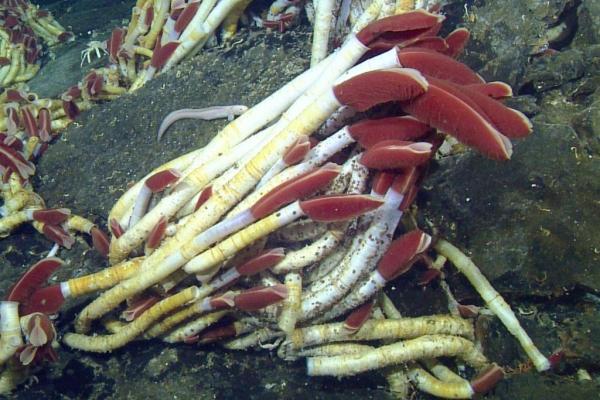
Aug. 4 (UPI) — At the bottom of the ocean lie hydrothermal “chimneys” the height of 10-story buildings that spew superheated chemical fluids into an oxygen-deprived, lightless void. These hydrothermal vents nourish communities of otherworldly creatures – such as 6-foot-long tubeworms that lack mouths and digestive tracts – and create untold mineral wealth now coveted by countries and corporations.
The mineral deposits laid down over the eons by the sulfides emitted by hydrothermal vents contain copper, zinc, silver and gold. Over the next three weeks, the International Seabed Authority is meeting in Jamaica to, among other things, draft environmental regulations to govern the mining of the deep sea. The mission: to fulfill the United Nations-chartered organization’s mandate to preserve the biological diversity of the mostly unexplored seabed while allowing the extraction of metals that make possible smartphones, solar panels and other products used by the most committed environmentalist and rapacious industrialist alike.
That job just got harder.
A new discovery appears to blow a hole in a major premise of seabed mining – that if a marine ecosystem reliant on one hydrothermal vent field is destroyed, life will go on at adjacent vents and, over time, the mined site could be recolonized by the same species. Deep-sea expeditions led by scientists affiliated with the Monterey Bay Aquarium Research Institute have found that hydrothermal vent fields as close as 45 miles to each other have spawned unique animal life based on local geology and the particular chemistry of the fluids flowing through the hydrothermal chimneys. The Alarcon Rise vent field at the southern end of the Gulf of California off Mexico, for instance, shares just seven of 61 animal species with the Pescadero Basin vent field less than 50 miles to the north, according to the study published in the Proceedings of the Royal Society B.
“Someone might want to mine the Alarcon Rise for precious metals and would say the Pescadero Basin is right next door so there will be a movement of animals between the two. But that’s not the case,” said the study’s lead author, Shana Goffredi, a marine biologist at Occidental College in Los Angeles who works with MBARI.
In fact, the Pescadero Basin hydrothermal vent field and its marine life are unlike any yet discovered.
Similar to other hydrothermal vent fields, the Alarcon Rise, discovered on a 2012 MBARI expedition, lies at a depth of about 7,550 feet and is covered in geologically young lava that spews sulfide-rich liquids at temperatures as high as 680F.
Pescadero, on the other hand, lies at a depth of 12,000 feet and hydrothermal fluid flows through thick seafloor mud, creating pools of methane and hydrocarbons.
“This combination of habitat characteristics is unlike any seen on Earth,” said Goffredi of the Pescadero vent field, which MBARI discovered on a 2015 expedition. “There’s the possibility that these sites are unique but there’s also the possibility that as we explore other sites, we’ll find others like it or other unique sites.”
The scientists sent remote operated vehicles to the vent fields to video the marine life, retrieve biological specimens for DNA analysis and collect fluids for chemical analysis.
At least 10 species found by the MBARI expeditions are new to science. But all hydrothermal vent creatures are unique in that life does not rely on light – photosynthesis – but chemicals. Seabed bacteria synthesize the minerals from hydrothermal vents and provide nutrition to tubeworms, clams and other animals. “These are habitats that we didn’t know about until the 1970s and they rely on chemical energy, not light energy,” said Goffredi. “The base of the food chain and the foundational animals that create the rest of the habitat is this bacteria.”
The MBARI scientists found that even nearby thermal vent fields that share similar geological traits to Alarcon Rise developed unique ecosystems. Alarcon, Pescadero and two other relatively close vent fields shared only three species of 116 identified at the sites, with 73 occurring at only one vent field, according to the study.
“How important are these sites to the rest of the deep sea?” asked Goffredi. “Is it underpinning the health of the region? That’s something we’re still trying to figure out.”
The International Seabed Authority has issued exploration licenses to private companies and state-owned corporations that cover close to 500,000 square miles of the seabed outside national jurisdiction. (The vent fields explored by the MBARI scientists are within Mexico’s Exclusive Economic Zone that extends 200 miles from its coastline.)
Most exploration licenses are for areas of the seabed that contain potato-size polymetallic nodules rich in manganese, nickel and cobalt. Others are for ferromanganese crusts found in underwater mountains called seamounts. An expedition by scientists in the United Kingdom recently discovered that a single seamount in the Atlantic Ocean contained tellurium – a key material in some solar panels – in concentrations 50,000 times greater than found on land.
Goffredi said the MBARI expedition underscores the need to conduct biological surveys to determine the biodiversity of vent fields before allowing mining. “I imagine that mining companies will be visualizing these sites by sonar mapping so you can see the chimneys on the seafloor,” she said, noting that 285 vent fields have so far been discovered. “The habitats will look all the same but it’s not until you send an ROV or sensors down there that you understand that they’re different.”
In advance of the International Seabed Authority’s meeting this month to develop environmental regulations for deep-sea mining, a group of leading marine biologists published a letter in the journal Nature in July warning about the impact on seafloor biodiversity.
“Most mining-induced loss of biodiversity in the deep sea is likely to last forever on human timescales, given the very slow natural rates of recovery in affected ecosystems,” the scientists wrote. “It is incumbent on the International Seabed Authority to communicate to the public the potentially serious implications of this loss of biodiversity and ask for a response.”
![]() Todd Woody is executive editor for environment at News Deeply. This article originally appeared on Oceans Deeply, and you can find the originalhere. For important news about ocean health, you can sign up to the Oceans Deeply email list.
Todd Woody is executive editor for environment at News Deeply. This article originally appeared on Oceans Deeply, and you can find the originalhere. For important news about ocean health, you can sign up to the Oceans Deeply email list.






